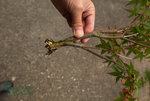I've found that layers can survive with very few roots, especially when dormant. I've had to remove some with little more than callus and they have just powered away the following spring. Come spring the tree will be programmed to grow roots really quick. Over here in a mild climate roots will slowly form during winter. After all, maples can grow from cuttings with no roots at all so a layer with some roots is streets ahead.
How valuable is the layered branch? Worth taking a chance? Why not remove it now, pot up and put it in your normal maple wintering area and let us know the results.
Good to know on your 1st point, thanks.
You said "Come spring the tree will be programmed to grow roots really quick".
Should a clean up of the girdle ensue prior to a specific timeframe?
I believe I will wait till March to inspect the roots.
I suspect the movement of the soil/cup has damaged the roots every time the wind blows
so I probably should tape the base of the cup to the branch, or use screws and wire to secure it.
On your 2nd point, do expand on the value query.
If the layered branch bears value in mind, is it more safe to leave it be...or do as described
to pot it up now and let you know the results? This may be an opinion thing like soils
or more specific to the cultivar used, I don't know.
I do know the Mountain Maple I collected and bare rooted last Spring into bonsai soil is doing well.
These are my 1st layer attempts, and the branches are of value more than just being my 1st.
They're strategic as should be, but the Autumn Moon is quite out of sorts without this branch
and the tree itself holds some sentimental value as well.

This is the Autumn Moon and the roots are considered to be on the weaker side compared to palmatum.
Being a dwarf the Wilsons Pink is probably a bit more sketchy than standard palmatum to layer, but it sure
showed good signs of top growth this Summer and I did see a root or 2, but that's all I've seen without
removing the soil. These Rooter Pots do not allow for any delicate inspection of weak root systems.
The plastic sides sort of button together in a way that only well rooted layers should be tampered with.
Maybe I'll get a pic up of them before it rains tomorrow.




